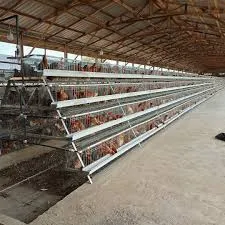cages for layer poultry
Nov . 12, 2024 01:09 Back to list
cages for layer poultry
Cages for Layer Poultry An Overview
In the poultry industry, the rearing of layer hens is a critical component of egg production. As the demand for eggs continues to rise globally, the methods in which these birds are housed and managed have become the subject of considerable discussion and development. One of the predominant systems employed in layer poultry farming is the use of cages, often referred to as battery cages or enriched cages. This article aims to provide an overview of the types of cages used for layer poultry, the advantages and disadvantages of such systems, and the evolving practices surrounding poultry welfare.
Types of Cages
Layer poultry housing can primarily be categorized into conventional battery cages and enriched cages. Conventional battery cages are small enclosures that typically house 3 to 6 hens. These cages provide minimal space for the birds, often resulting in limited movement and natural behaviors. In contrast, enriched cages were developed to address animal welfare concerns associated with traditional battery cages. These cages are larger and include features such as perches, nesting boxes, and scratching areas, allowing hens to engage in more natural behaviors.
Advantages of Caged Systems
Caged systems, particularly conventional battery cages, offer several benefits to poultry producers. First and foremost, they maximize space efficiency. By allowing farmers to house more hens in a compact area, they can significantly increase production output. Additionally, caged systems facilitate easier management of the flock. Farmers can swiftly monitor the health and productivity of their hens, as the birds are contained within a confined space. Moreover, these systems can reduce the risk of disease transmission, as the risk of contamination from droppings is minimized.
The economic aspect is another compelling reason for using caged systems. The initial investment for cage systems can be lower than that of free-range or barn systems due to the reduced land requirement and feed costs. The efficiency of feed conversion into egg production can also be higher in caged environments, which can lead to better overall profitability.
cages for layer poultry

Disadvantages and Welfare Concerns
Despite these advantages, the use of cages in layer poultry systems has raised substantial welfare concerns among advocates and researchers. One significant issue is the confinement of hens, which can lead to detrimental effects on their physical and psychological well-being. The lack of space restricts natural behaviors such as nesting, perching, and foraging. This confinement can result in increased stress levels, aggression, and abnormal behaviors, such as feather pecking.
In response to growing animal welfare concerns, many countries have begun to phase out conventional battery cages in favor of enriched cages or alternative housing methods. For example, the European Union has implemented regulations that require all egg production facilities to transition to enriched cages, thereby enhancing the quality of life for layer hens.
The Future of Layer Poultry Housing
As consumer awareness regarding animal welfare continues to grow, the poultry industry is experiencing a shift towards more humane practices. Many producers are now exploring alternatives to caged systems, including free-range and barn-raised options. These systems allow hens greater freedom of movement and the opportunity to exhibit natural behaviors. However, they also come with challenges, such as higher production costs and increased management complexity.
In conclusion, while caged systems for layer poultry offer various operational advantages, the welfare implications cannot be overlooked. The demand for more ethical farming practices is prompting a reevaluation of housing methods within the poultry industry. As stakeholders strive to balance productivity, economic viability, and animal welfare, the conversation around cages for layer poultry will continue to evolve. The future may see a blend of innovative housing solutions that prioritize both the efficiency of egg production and the well-being of the hens, ensuring a sustainable and humane approach to poultry farming.
-
Hot Sale 24 & 18 Door Rabbit Cages - Premium Breeding Solutions
NewsJul.25,2025
-
Automatic Feeding Line System Pan Feeder Nipple Drinker - Anping County Yize Metal Products Co., Ltd.
NewsJul.21,2025
-
Automatic Feeding Line System Pan Feeder Nipple Drinker - Anping County Yize Metal Products Co., Ltd.
NewsJul.21,2025
-
Automatic Feeding Line System - Anping Yize | Precision & Nipple
NewsJul.21,2025
-
Automatic Feeding Line System - Anping Yize | Precision & Nipple
NewsJul.21,2025
-
Automatic Feeding Line System-Anping County Yize Metal Products Co., Ltd.|Efficient Feed Distribution&Customized Animal Farming Solutions
NewsJul.21,2025






